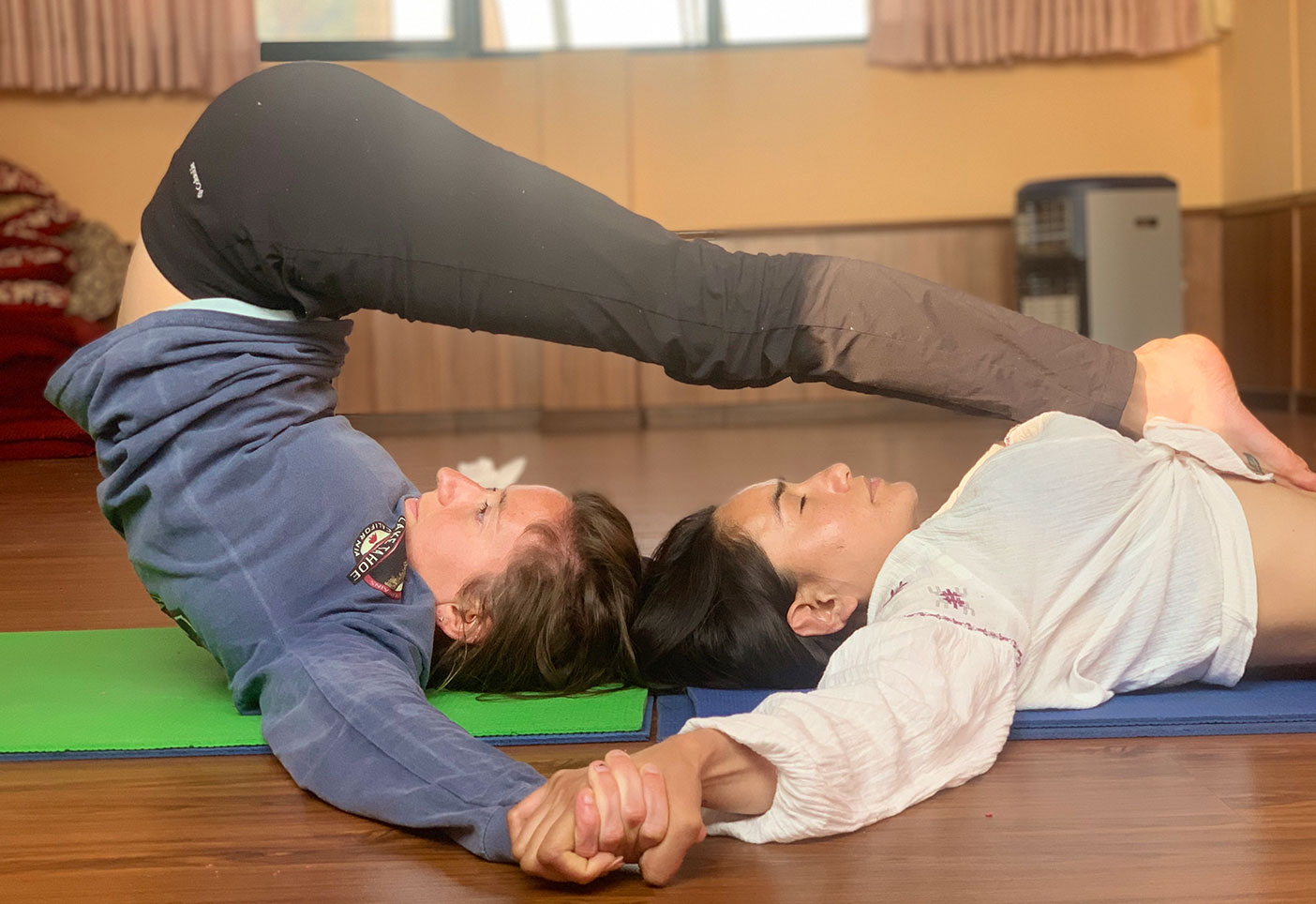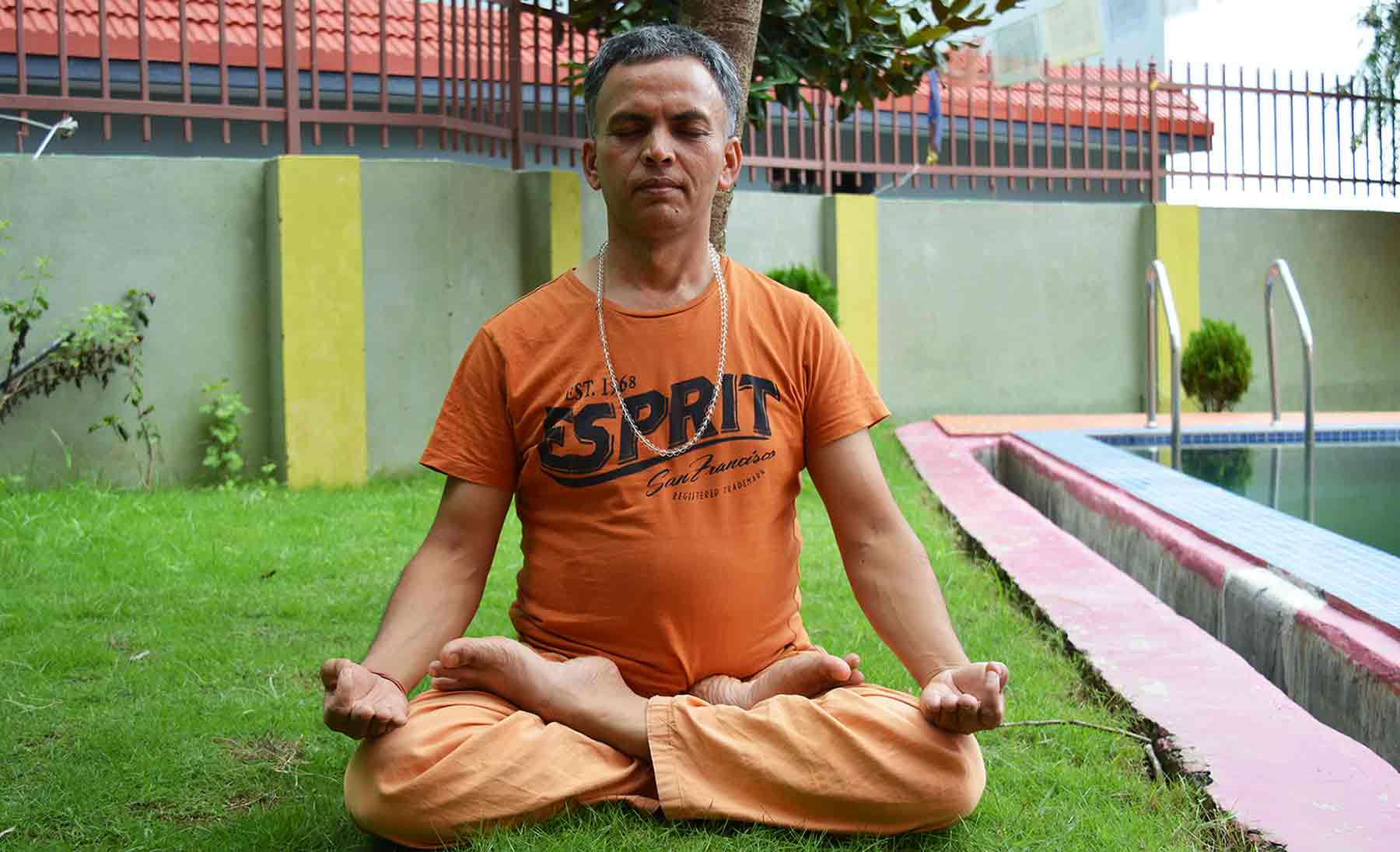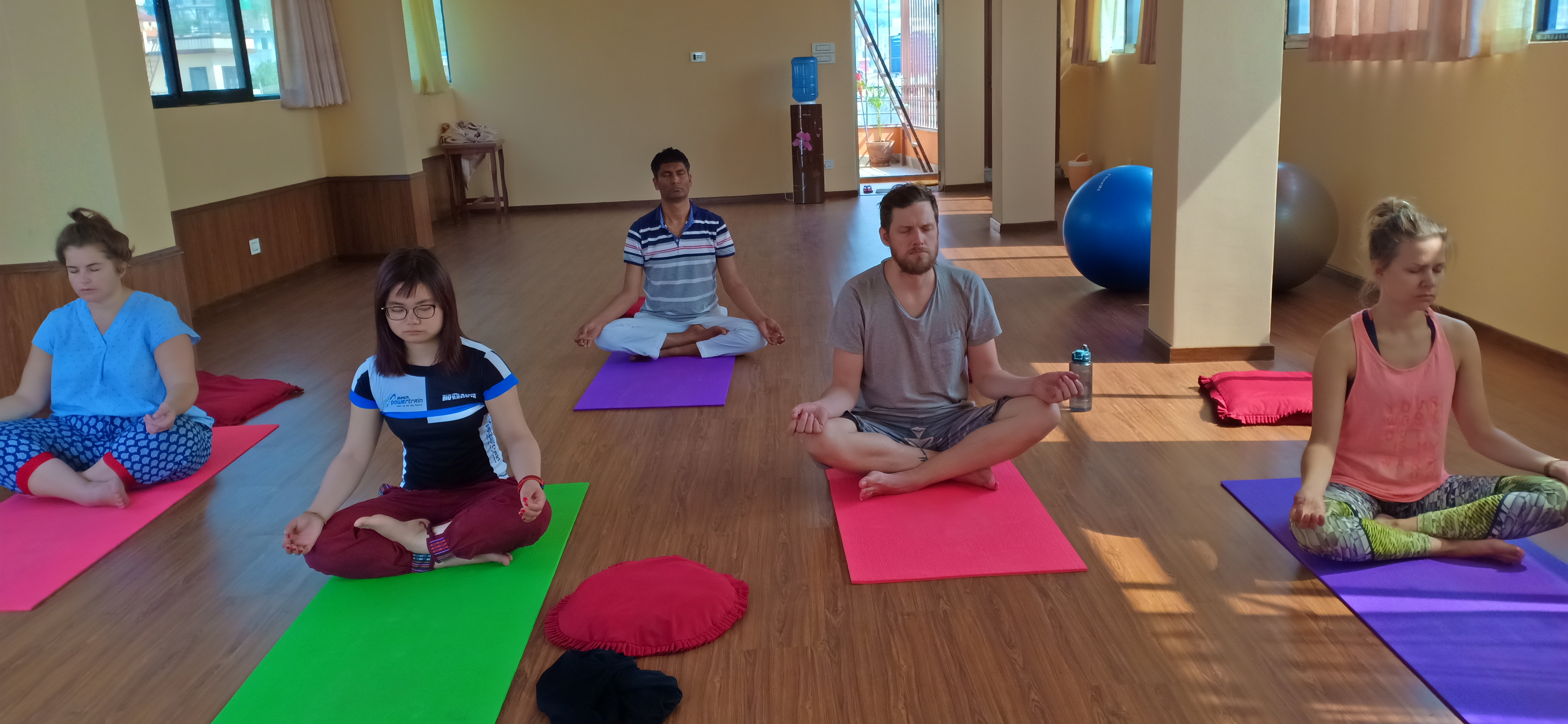
7 Jun 2019 HYN Himalayan Yoga Academy
-Yogacharya Subodh Simkhada
Abstract: Antaranga Yoga, a path of samadhi
Antaranga Yoga, a path of samadhi: Samadhi is the equanimity of mind; the original form of self. Samadhi means ‘sama’ + ‘dhi’; sama – equanimity and dhi – intellect/wisdom means the equanimity of intellect. It gives the sense of concentration of the mind purposed to expand the consciousness. In the early sacred text of Rig Veda, the word Samadhi refers the getting rid of miseries and also the spiritual exploration to the realization of the sat-chitta-ananda i.e. true conscious bliss. As the references of the Nath Cult, the word yoga refers the path of physical austerity but its gate is always open towards spiritual perfection, the Samadhi throughout the Saptanga / Hatha Yoga by Maharshi Gheranda.
Then Yoga Darshan, the modified version of pure yogic text modified by Patanjali refers initially to the ethical and physical foundation of life, followed by generating Prana (vital force), harmonizing the mind and illuminating the intellect in respect of sensory organs, mind, and egos. Patanjali holds that ignorance is the cause of suffering. Moksha or Samadhi like many other schools is the purpose of ignorance, which is achieved through discriminative resolution, knowledge, and self-awareness. Yoga Sutra formulations are one of the foundations of the traditional Yoga Philosophy of Human purposed to realize Nirvana through Samadhi, the supreme consciousness.
Yoga, a state of devoid
YOG (Sanskrit) – Root- ‘Yuj’ means to unite, to join, to add, to bind, or to yoke
Human Life = Body + Breath = Rhythmic Breath/Body + Mind = Soul; So, Yoga = Body/ Breath + Mind + Soul = Union = Self realization/Liberation
Sanskrit, the Indo-European language of the Vedas, eastern ancient sacred texts, gave birth to both the literature and the technique of yoga. One definition of the word Sanskrit, “well-formed, refined, perfect or polished,” connotes substance (existing in a person) and clarity, qualities exemplified (to illustrate) in the practice of yoga. The Sanskrit word yoga has several translations and can be interpreted in many ways. It comes from the root ‘yuj’ and originally meant “to hitch up,” as in lifting into a higher position or attaching horses to a vehicle. Another definition was “to put to active and purposeful use, as the science of consciousness.” Essentially, yoga has come to describe a means of uniting or a method of discipline.
It is not the science of the body; it is the science of life, a science of existence under universal phenomena.
Yoga is more about mastering postures and increasing your flexibility and strength.
Yoga = 3B + MS
B stands for Body movement; B stands for breathing movement; B stands for Blood Circulation
Plus M stands for Mind fullness; and S for spiritual exploration
Definition of Yoga:
- “Yogaschittavrittinirodhah” PYS 1.2 – Patanjali Yoga Sutra—–
Meaning: the cessation of modified thoughts in chitta (more about Mind) is yoga.
2. Yogah Samadhi-Bhagbhat Gita
– Yoga is itself Samadhi (Liberation)
State of Self-realization, fully conscious mind/ self guided/ devoi
MISSION –A journey of self, throughout self, to the self
Adhiktam Swasthya—-Optimum Health – Minimum requirements
Parama-shanti/ Shuddi/ Vishrama/Sahaj–Supreme-Peace/Purity/ Rest/Relaxation
Parama-sukhah/ Santosha————- Supreme-happiness/ Contentment
Aatma-anubhuti————————– Self-realization
Parama-chetana————————- Supreme-consciousness
Prama-aanada—————————- Supreme-Bliss
Moksha/Mukti—————————- Liberation / Isolation
“The traditional purpose of Yoga, however, has always been to bring about a profound transformation in the person through the transcendence of the ego,” In Hinduism, Buddhism, and Jainism the word yoga means “spiritual discipline“. People often associate yoga with the postures and stances that make up the physical activity of the exercise, but after closer inspection, over time it becomes clear that there are many more aspects of yoga. It is an activity that has been practiced for thousands of years, and it is something that has evolved and changed overtime.
Different factions of yoga have developed since its conception.
- Individual Development: State of Physical, Mental, Emotional, Social, Spiritual, Ecological health etc.
- Socio-cultural Development: No Difference in Diversities, Languages, Cultures, Traditions, Costumes, Religions, Castes, Politics, Economics, Geography, etc.
- Professional Perfection: Yogic signs can be seen like qualitative, believable, durable and honorable in any professional / occupation / Business.
- Spiritual Perfection: We move to have the achievement, happiness, libration and isolation.
Forms of Yoga:
Generally, there are two types of Yoga, Bahiranga (External) Yoga and Antaranga (Internal) Yoga; practically classified into Hatha and Raja Yoga. According to Patanjali, Yoga is classified into eightfold paths called Ashtanga Yoga. Generally, people understand that Ashtanga Yoga is a form of yoga but it is not true, it is the totality of yoga, only summarized and modified all scatted yoga and yogic messages in different ancient texts and yogic minds. Out of these first 4 limbs are considered Bahiranga, 5th one is a bridge or mediator, and the last 3 limbs are Antaranga.
Patanjali’s teachings in the Yoga Sutras form part of the scriptural foundation of yoga philosophy. It is thought that Patanjali compiled the Yoga Sutras from older yogic texts; however, they contain a lot of original material as well. Patanjali is highly regarded for the clarity he brought to yogic philosophy and his work continues to inspire yoga instruction to this day.
The collection contains what is thought to be much of the basis of classical yoga philosophy and is made up of 196 sutras (“threads” or discourses).
The 196 sutras are compartmentalized into four topical books:
Samadhi pada (what yoga is)
Sadhana pada (how to gain a yogic state)
Vibhuti pada (benefits of practicing yoga regularly)
Kaivalya pada (liberation or freedom from suffering)
In the modern context, yoga is most often associated with the physical practice of asanas, particularly stretching exercises to build flexibility and relax the body. Yoga asanas can also build strength, coordination, balance, and, stamina. However, this is only one aspect of yoga as asana practice is just one of the “eight limbs” of yoga as listed in Patanjali’s Yoga Sutras, a key sacred text on the philosophy of yoga.
These eight limbs are:
Bahiranga Yoga
- Yama – Five abstentions (or outer observances)
- Niyama – Five inner observances
- Asana – Meaning “seat” and referring to the physical posture needed for meditation
- Pranayama – Controlled or suspended breath
Mediator – Neither external nor internal
- Pratyahara – Withdrawal of the senses
Antaranga Yoga/ Raja Yoga
- Dharana – Single pointed concentration
- Dhyana – Meditation
- Samadhi – Liberation
There are many different paths of yoga, including Hatha, Mantra, Laya, Raja Yoga, Karma Yoga, Bhakti Yoga, Jnana Yoga, and Dhyana Yoga but all are rooted in the yamas and niyamas. And have the same goal of samadhi. Yoga is thought to be therapeutic for many physical and mental conditions.
Studies have been carried out demonstrating its effectiveness as a treatment for back pain, stress and schizophrenia, to name a few.
Ultimately it is understood by two ways external and internal;
Life management = Body Management + Mind Management ( Internal Yoga) verses Hard ware + soft ware (Internal Yoga) = Yoga
Hatha Yoga: Hatha Yoga Pradipika–
The purpose of Hatha yoga is to discipline the body and mind and empower the body through Cleansing acts, Postures, breathing acts, some mudras, and bandhas. Factors to failure and success in Yoga depend on Sadhana -mitahara – relation of Mind and Prana – importance of Nadisuddhi – techniques and benefits of Shat Karmas and Asta-Kumbhakas; Signs of perfection as external Yoga in Hatha Yoga. So, Antaranga Yoga, a path of samadhi
As Internal Yoga Practice:
Classification of Mudras –- the influence of Seasons on Yoga- Sahita and Kevalikumbhaka –Pratyahara techniques- three types of dhyana- Sthula, Jyotir and Sukshma
Concept of Nada and Nadanusandhana in Hatha Pradeepika
Concept of Kundalini – Bandhas, Mudras and their importance in Kundalini awakening – Synonyms and process of Samadhi – techniques of Shambhavi and Khechari mudras – Concept of Nadanusandana
Gehranda Samhitha: Sapta Sadhanas
– Shatakarmas –Asanas; mudras, Pratyahaara, Pranayama Practical Approach tends to external yoga and Dhyana and Samadhi tend to internal yoga in Gheranda Samhita
Pratyahaara as an entrance for Antaranga Yoga or Raja Yoga:
Pratyahara means withdrawal of senses. We have five gross senses eyes –a sense of vision; ears –a sense of hearing, tongue – a sense of taste, nose – a sense of smell, and skin – a sense of touch. These organs of perception cannot be withdrawn. Information is transmitted from gross organs to the corresponding cerebral center in the uppermost part of the brain. The corresponding cerebral center makes a connection with the mind, Egos, and wisdom – the Antarakarana, which is lighted by the self seated at the Bindu chakra in the blissful sheath. It orders the subtle organs –indriyas to contact the source of stimulus.
In the process of pratyahara, the subtle sense-organs are withdrawn into Egoity which is evolutes of the evolving intellect. In the course of evolution, the ego is evolving and five senses organs are the evolutes. As a result of this withdrawal, the subtle sense-organs can’t reach the source of stimuli and sense-perceptions are blocked.
We have to initiate the pratyahaara in order to proceed each session of meditation. Each physical base practices are means of transport for pratyahaara, pratyahaara is the means of transport of Meditation and ultimately meditation is the final means of Yoga or Samadhi. It improves the power of concentration. A meditator, without the previous practices like subtle exercises, Postures, bandhas , mudras, and also pratyahaara, can hardly get full success in meditation.
Techniques of Pratyahaara:
Frequent concentration on different action brings the other senses withdrawn.
-Use of six senses e.g. Mind by soothing & calming; eyes by gazing; ears by hearing Mantra, kirtan, chants, singing, sound of creatures & nature; nose by smelling ; tongue by tasting & eating each foods silently; skin by feeling the climate, temperature, etc.
-Use of Mantra Japa
-Yoga nidra- psychic sleep
Practice of Antaranga Yoga or Raja Yoga:
Dharana, Dhyana and Samadhi are collectively called Raja Yoga or Antaranga Yoga which are the 6th, 7th and 8th limbs of Ashtanga Yoga. These three, done together, are combinedly known as samyama. Out of these, main means is Dhyana-Meditation.
Purity, Peace, Rest and Relaxation, four pillars of Meditation
Resting and relaxing the body is the final most important stage of normalizing the body and mind and maintaining wellbeing. This is done through the practice of asanas, pranayama, and meditation it loosens body and mental tension; relaxes the muscles, releases tiredness, regulates the the body’s physiologies, and connects body and mind.
This phase triggers the brain to parasympathetic mode which alleviates stress and brings homeostasis and balance to our bodies. When the body is in parasympathetic mode the heart rate is slowed down, the pupils are constricted, and the digestion is returned to normal.
Yogic relaxation helps increase immune strength, reduce anxiety, stress, tension, and pain, and bring awareness and higher consciousness. Some asanas that are helpful for the rest phase include:
- Shavasana – lying in supine position with feet apart and palms facing upwards eyes closed it is also called corpse pose
- Shishusayanasana (Child pose) -in a resting position similar to that of a young child
- Makarasana – lying flat on stomach with legs straight heels facing outwards, arms folded and head gently resting also known as crocodile pose
- Pasuvishramsana – sitting in a loose comfortable meditative like position with support by chair or wall.
Some of the rest patterns for proper relaxation can be used; Antaranga Yoga, a path of samadhi.
1. Spinal rest technique- completes resting technique for spinal cord
2. Instant rest technique- tensing whole body then releasing
- Prasanta bhava techniq ue- Maintaining a rest position like an animal
- Quick rest technique- lying in shavasana observing the movement of the natural breath and in particular the upward and downward motion of the abdomen. This is done with long deep inhalations and exhalations whilst feeling relaxation

Meditation
Meditation as the final aspect or device of yogic practice following all the above-mentioned practices opens the doors of intuitive knowledge and realms to eternal bliss. It is the state of mind which is free of object perception. By long-term regular practice and renunciation, one can control the mind and meditate to deeper levels. One can experience the inner quality and power. Meditation is not done, we let it happens. Meditation is an adventure into silence. In Meditation, there is no action, no tension, and no emotion. We do not put any effort into meditating. The art of sitting silently is a fundamental requirement for meditation. It is the final weapon for Yoga or Samadhi.
While meditating once should remain conscious over the following acts:
Technique-1
– One should free the mind of trash, still the thought waves and try to end the infatuation of the mind in order to still it.
– One should have faith and unmoving confidence.
– One should have devotion, perseverance, and full control over the senses
-One should have total purity, awareness, and happiness.
One simple method of meditation involves:
1. Sitting in any comfortable meditation position with an erect spine and eyes gently closed and hands in Gyana or China mudra and so on
Starting from the prayer mantra of “Om Namo Guru Dev Namo”x3
- bringing awareness to long and deep breathing intervals
- Chanting Om mantra continuously and rhythmically for 10 to 15 minutes bringing awareness to the inner vibrations.
- Finally lying down in shavasana feeling the energy vibrations for 5 minutes.
Technique -2,
- Sit in any meditative asanas comfortably, keep your back straight, hand rest in knees in any hand mudras, close your eyes.
- Relax the deha dharana (body) by relaxing joints, muscles, vessels, limbs etc.
- Prana dharana (breath) by naturalizing the breath
- and Mano dharana (mind) by keeping peaceful and calm mind
- Meditate on the idea of an earthen solid, aquatic fluid, fire, airy gases, and Aakash (space) in succession, the duration of each one is 3 minutes.

Practice for Samadhi
The mediator fixes his attention on one idea only and the idea flows continuously without interruption. In Samadhi, the meditator remains in a thoughtless state. This state is devoid of material existence, devoid of forms, attributes, and actions, and devoid of thoughts. As a molecule of sodium chloride dissolves in the seawater and apparently loses its separate identity, so does a yogi become completely absorbed in Brahman in the Samadhi state.
Technique of Samadhi-
- Take a symbol of any divine sound like AUM which stands for Brahman as a monosyllable OR a swastika symbol
Anyone else may be adopted to represent the particular symbol.
- Sit in a comfortable meditative posture with closed eyes and visualize the symbol at the eyebrow center which is the seat of intellect, ego, and mind. Now meditate on the symbol and mentally repeat the divine sound of the mantra. Slowly erase the picture of the symbol from the mind’s memory and remain in a thoughtless state as long as you can.
Conclusion
Samadhi is the state where ecstatic awareness develops, and this is how one starts the process of becoming aware of Purusha and the true self. It further claims that awareness is eternal and once this awareness is achieved, a person cannot ever cease being aware, this is Samadhi. Samadhi is that spiritual state when one’s mind is so absorbed in whatever it is contemplating, that the mind loses the sense of its identity. We describe yoga and then the nature and the means to attaining Samadhi. The thinker, the thought process, and the thought fuse with the subject of thought. There is oneness, Samadhi.
References
- Acharya Bhagawan Dev, Pranayam, Kundalini & Hatha Yoga; Diamond Books, Delhi.
- N.C Panda; – Meditation Science and practice; D.K. print world (P) Ltd.
- Yogacharya Subodh Simkhada, Scientific Experience of Yoga; Himalayan Yoga Academy, Kathmandu Nepal.
- Swami Vishnu devananda, Meditation and Mantras; Motilal banarsidass publishers, Delhi, India
- Swami Vivekananda, Yoga Therapy for Positive Health; Yoga Prakashana, India.
